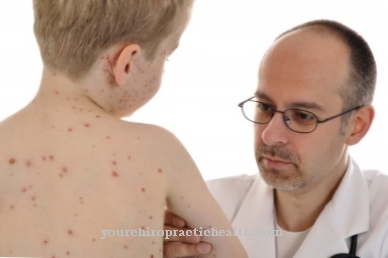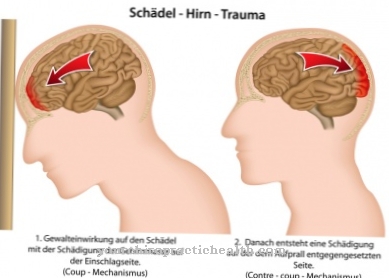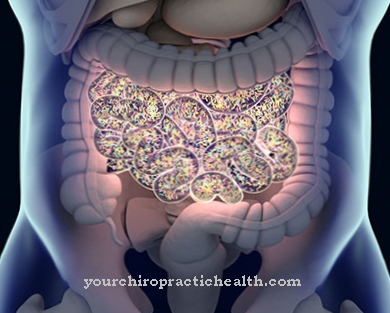The medical terms for the rather trivializing name Snow blindness are actinic keratosis and photokeratitis. It is damage to the cornea of the eye caused by strong UV radiation, as can typically occur when staying in the snow at high altitudes or, e.g. B. by observing the electric welding with the unprotected eye. Depending on the severity of the burns on the cornea, snow blindness can be extremely painful and trigger a foreign body sensation in the eye. In more severe cases, immediate ophthalmological treatment is recommended.
What is snow blindness?

© Netzer Johannes - stock.adobe.com
The two medical terms actinic keratosis and photokeratitis indicate damage to the cornea caused by radiation or light. The cornea closes off the eyeball from the outside and takes on important functions for seeing such as refraction of light and the unobstructed passage of incident light rays.
The outermost layer of the cornea, which - similar to "normal" skin - is constantly renewed, is always moistened with tear fluid in order to be able to perceive its functions. If the UV radiation is too strong, the outermost layers of the cornea can literally be "burned", which then constitutes snow blindness.
Since the cornea of the eyeball has numerous nerve endings through it, damage to the cornea as a result of UV radiation can lead to severe pain and extreme sensitivity to light after a latency period of 3 to 12 hours.
causes
The unprotected eyes can tolerate daylight and sunlight (not directly into the eyes) in normal snow-free surroundings without being damaged. An increased UV component in sunlight can lead to repairable, but also irreparable damage to the cornea.
The cornea absorbs a large part of the UV-A and UV-B components in sunlight and thus protects the retina and especially the macula on the back wall of the eyeball, the small area of the retina with which we can recognize colors and see clearly . If the UV-B component in the incident light becomes too strong, the uppermost layers of the cornea swell up like an edema and uncontrolled erosion of the dying cells occurs.
This process is comparable to that of mechanical damage to the cornea. An increased proportion of UV, to which the eye should not be exposed unprotected, occurs above all in high mountains during skiing, on the sea in southern latitudes and at great heights (aircraft cockpit).
Symptoms, ailments & signs
If the eyes are exposed to sunlight for too long without protection, they can be damaged. Snow blindness is roughly comparable to sunburn of the skin. Instead of the skin on the back or shoulders, the calluses and conjunctiva burn here. The snow reflects the sunlight particularly strongly. Therefore, the complaints occur especially after spending time in the snow. Symptoms appear a few hours after unprotected eye contact.
It can take up to twelve hours for the person affected to get severe pain in their eyes and feel a foreign body sensation. The patient thinks they have got sand in their eyes and feels the urge to rub it out of their eyes. The conjunctiva turns red and swells. The symptoms are roughly comparable to conjunctivitis.
The eyes also often begin to water. An eyelid cramp is also typical for snow blindness. Since the eyes are particularly sensitive to light, the affected person often closes their eyelids. This happens compulsively. The disease, also known as photokeratitis, can also cause slight visual disturbances.
In some cases, sunburn was also observed on the skin at the same time. The symptoms are mostly harmless and subside within two days at the latest. If this is not the case, the ophthalmologist should be consulted.
Diagnosis & course
Reddened and slightly burning eyes can be the first indication of snow blindness. If the eyes have previously been exposed to increased UV radiation without protection, e.g. B. by skiing in the high mountains or after spending hours at sea, this confirms the suspicion of snow blindness.
If the symptoms worsen, an examination and diagnosis should be carried out by an ophthalmologist. How severely the cornea was damaged can be diagnosed using a slit lamp and fluorescein staining.
Severe cases of photokeratitis can lead to irreparable impairment of vision due to scarring in the cornea. If one or more of the symptoms described below occurs, specialist medical care should be sought immediately:
Complications
Snow blindness or lightning can be associated with severe pain because the nerve endings of the UV-damaged outer cornea are exposed. At the same time, the eyelids cramp up so that it is no longer possible to open the eyes. Depending on the severity of the flash, the eyesight can be lost for hours or days.
In order to calm the eyes and, if necessary, to treat them with antibacterial agents and in this way to prevent possible complications, it is essential to see a doctor - even if the symptoms seem to subside quickly. Complications can arise from additional inflammation of the cornea. Peeling of the retina is also possible as a result of flashing, which lengthens the healing process, prolongs the painful sensations and takes a longer time to regain vision.
Without medical treatment, there is a risk of super or secondary infections. This leads to an additional bacterial infection of the damaged tissue. This in turn threatens permanent blindness in the worst case. Complications during the healing phase or any additional pain should be reported to the attending physician in any case so that the treatment measures can be adjusted if necessary.
When should you go to the doctor?
If you are snow blind, you should always consult a doctor. In the worst case, snow blindness can lead to complete blindness of the person concerned and therefore make the patient's everyday life much more difficult. In order to prevent further complications and discomfort, the person affected should consult a doctor at the first sign of snow blindness. See a doctor if your eyesight is reduced and the conjunctiva becomes red or even swollen. A doctor should be consulted, especially after staying in snowy areas, if these symptoms appear and do not go away on their own.
In general, visual disturbances are indicative of snow blindness and should be investigated if they have occurred for no particular reason. As a rule, a doctor should be consulted after two or three days at the latest if these symptoms have not gone away on their own. The snow blindness is treated by an ophthalmologist. In emergencies, however, you can also go to a hospital. The life expectancy of the person affected is not restricted by snow blindness.
Treatment & Therapy
Lighter forms of snow blindness heal by themselves after 2 - 3 days, because the uppermost layers of the cornea regenerate by natural replenishment. Similar to the skin, newly formed cells are constantly being replenished for the rejected cells.
As immediate measures for severe forms of snow blindness, stay in a darkened room, bed rest and cooling pads on both eyes are announced. In more severe forms of the disease, the therapy aims to treat pain, prevent infections in the injured cornea and support measures to promote the natural regeneration of the cornea. For the treatment of acute pain, only one application of locally effective eye drops is recommended, because repeated application of the drops intensifies the already existing damage to the epithelial layer of the cornea.
If pain persists, systemic pain management using common pain relievers such as ibuprofen and others can provide relief. Anti-inflammatory and analgesic eye drops can also be used. Disinfecting eye ointments containing antibiotics can be used to prevent superinfections on the cornea.
You can find your medication here
➔ Medicines against photosensitivity and irritated eyesprevention
The best protection against snow blindness is provided by suitable sunglasses that almost completely filter out UV light up to 380 nm and also strongly filter out protection in the violet and blue range up to around 480 nm. Glasses that meet this requirement are marked with UV-400. For the other wave ranges, glasses offer good protection if the light transmission in the blue range is 2% - 8%, in the red to green range 10% - 40% and in the infrared range (above 780 nm) below 50%.
Aftercare
Follow-up care by an ophthalmologist is necessary and even indispensable for people with snow blindness. Severe disease can lead to irreversible damage to the cornea and conjunctiva. Medical follow-up care must be carried out simply because of such dangers, so that the eyesight of the person concerned is preserved. Professional aftercare is necessary to relieve the painful symptoms.
The direct influence of particularly intense UV radiation triggers the symptoms. With mild courses, no permanent damage remains. However, a follow-up check is advisable in order to double-check that the healing process has been completed. In the future, the patient can take care of himself by avoiding bright light sources.
Sunglasses have a supportive effect here. Another disease flare-up is prevented. Instead of aftercare, preventive care is useful in this case. If there is no noticeable improvement after two to three days, the ophthalmologist will arrange for further examinations. The aim is to determine which eye disease is actually the cause of the symptoms.
The healing progress is monitored during the follow-up appointments. Surgery may be required to completely eliminate the condition. Regular checks after the inpatient stay are always common. The doctor will check whether the eyes have healed as expected.
You can do that yourself
The best self-help measure for snow blindness is prevention. The risk of being struck by lightning is particularly high in winter sports in the high mountains. Therefore, when the weather is nice and in intense sunlight, sunglasses that are suitable for high mountains or suitable ski goggles should always be worn.
However, water does not only reflect UV rays strongly when it is frozen. There is therefore also a risk of snow blindness when doing water sports or when taking boat trips. Even crossing smaller bodies of water on a ferry can be risky in strong sunlight. Good sunglasses should therefore also be worn on these occasions. In tanning beds, protective goggles handed out by the staff must be used, as the risk of damage to the eyes from UV light is particularly high here.
If the eyes are flashed anyway, shade must be provided immediately and a doctor, better still an ophthalmologist, must be consulted. If those affected do not have protective goggles with them, they should borrow one for the way to the doctor in order to relieve the injured eyes as much as possible.
The eyes often react to the corneal erosion caused by UV radiation with severe itching, and a foreign body sensation often arises. However, under no circumstances should the eye be scratched or looked at, otherwise there is a risk of the damaged cornea becoming inflamed.


.jpg)





















.jpg)



